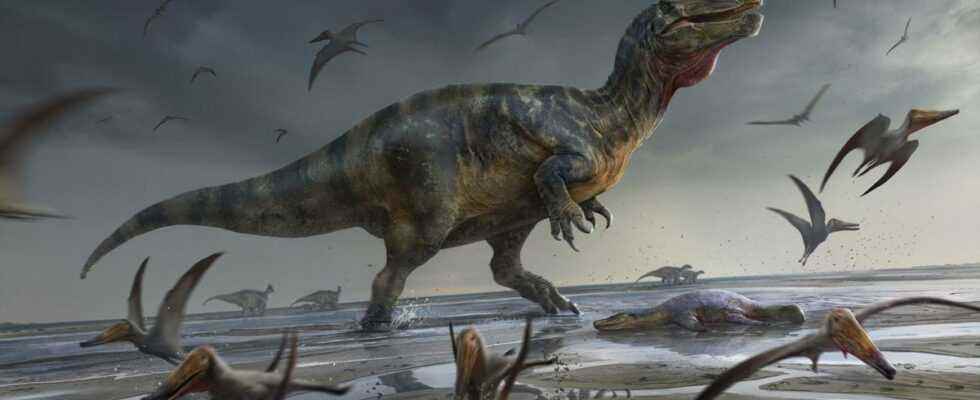Briton Nick Chase, a collector, unearthed some bones on the Isle of Wight. Researchers have managed to identify the beast, a bipedal spinosaurus, dubbed a “super predator”.
More than ten meters long and a crocodile’s head: the fossils of a 125 million year old carnivorous dinosaur, probably the largest predator to have lived in Europe, have been discovered on the British Isle of Wight, according to a study published Thursday, June 9.
Read also“We find a new species of dinosaur every week”
It is to a local collector that paleontology owes the precious find, the Briton Nick Chase, who spent his life searching the beaches of this island in the south of England, among the richest sites in Europe in dinosaur fossils. . From the few bones he had unearthed (cervical, caudal and sacral vertebrae in particular), researchers from the University of Southampton managed to identify the beast, a bipedal spinosaurus, this super-predator which lived in the Lower Cretaceous (between 145 million and 100 million years ago).
“It was a gigantic animal, exceeding 10 meters in length. Given some of its dimensions, it probably represents the largest predator ever discovered in Europe.“, according to Chris Barker, researcher in paleontology who led the study published in the journal Peer J.
Read alsoSpinosaurus, the first aquatic dinosaur
Admittedly, few of the individual’s bones have been unearthed so far, but “the numbers don’t lie: it’s bigger than the largest specimen ever found in Europe“, he underlines to AFP. The mighty carnivore indeed appearseven biggerthan another predatory dinosaur discovered in Portugal in 2017, confirms Thomas Richard Holtz, a paleontologist from the American University of Maryland not involved in the study.
SEE ALSO – Dinosaurs: a new gigantic species identified in Australia
“Like Herons”
However, the size comparison exercise remains difficult in this extinct world, recalls Matt Lamanna, dinosaur specialist at the Carnegie Museum of Natural History (Pennsylvania). And the largest of the spinosaurids was “probably not as massivethan the famous Tyrannosaurus-rex or the Giganotosaurus. The “White Rock Spinosaurus» («White stone“, where his bones were found), the name that scientists hope to be able to give to a new species, surveyed the place about 125 million years ago.
He would be the mostyoung» specimen of the spinosaur family discovered in Great Britain, including the famous Baryonyx, one of the protagonists of the film series «Jurassic Park“. This family is recognizable by its elongated head, like that of crocodiles, as opposed to the square skulls of T-rex. Some theories link this morphology to their mode of hunting, on land as well as in water. “They were a bit like storks and herons, wading and catching fish on the surface“, explains Chris Barker.
The giant’s fossils were discovered on the south-west coast of the island, in a lagoonal geological formation which revealed a still unknown historical stratum. “It helps us to depict the living conditions of these animals at that time.adds the researcher.
Read alsoMark Loewen: ‘Dinosaurs are still kings of the world’
On this treasure island, his team has already unearthed two new species of spinosaurids, including Ceratosuchops inferodios – baptized “hell heron“. The discovery of the super-predator comes “strengthen our arguments that this family of dinosaurs originated in Western Europe and diversified there, before spreading elsewhereacross the planet, added Darren Naish, co-author of the study. “Most of these extraordinary fossils were found by Nick Chase, one of the most skilled dinosaur hunters, who died just before the Covid outbreak”, commented Jeremy Lockwood, of the University of Porthmouth, also co-author. The collector has always donated his finds to museums, paleontologists point out.
SEE ALSO – ‘Baby Yingliang’: World’s best-preserved dinosaur embryo discovered in China
